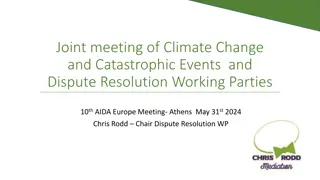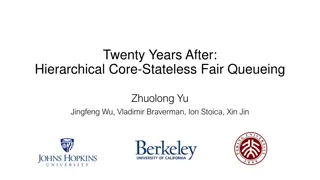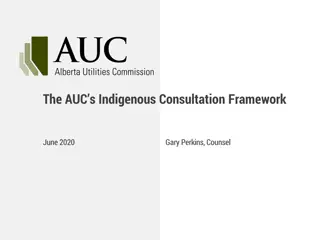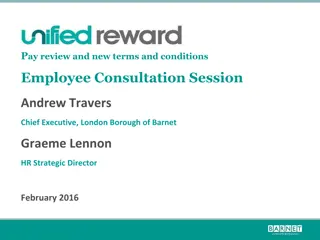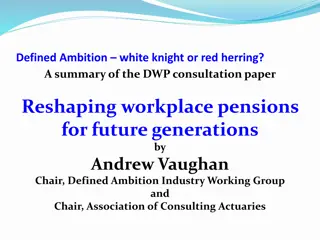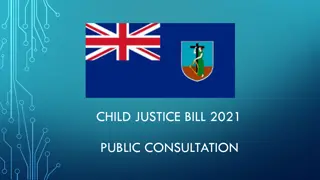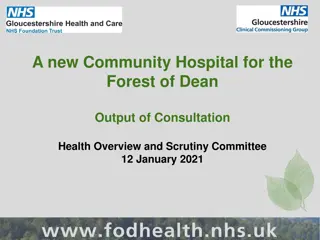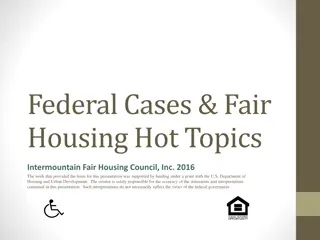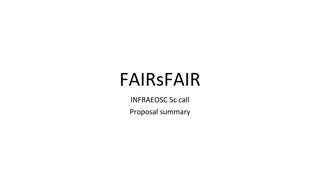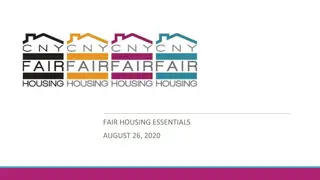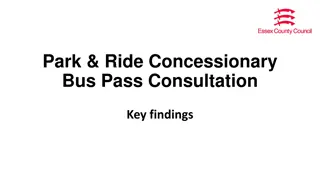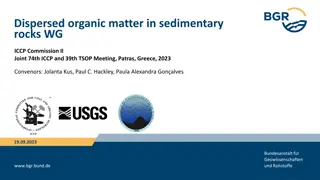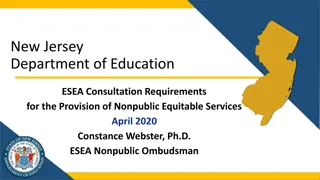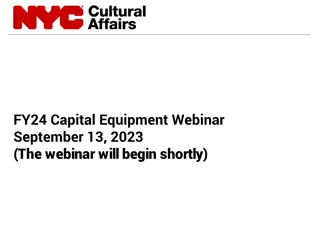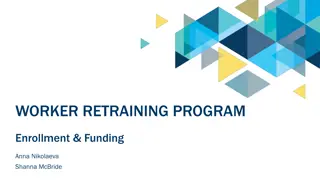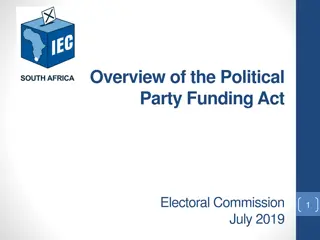Overview of Fair Funding Review Consultation Paper
CCN commissioned Pixel Financial Management to model potential implications of the Fair Funding Review (FFR) to support their responses to current and future consultations. The FFR consultation paper by MHCLG deals with needs in the formula, with future papers focusing on resources and damping. The consultation paper suggests a flatter formula based on cost drivers like rurality and sparsity, indicating potential for greater ministerial judgment. The overall funding structure includes the Relative Needs Formula (RNF), Needs block, Resources block, Central allocation, and Damping. The 2013 RNF is also discussed in terms of its cash value and adjustments. Various top-ups and indicators are analyzed, with suggestions for new indicators in the flatter formula design.
Download Presentation

Please find below an Image/Link to download the presentation.
The content on the website is provided AS IS for your information and personal use only. It may not be sold, licensed, or shared on other websites without obtaining consent from the author. Download presentation by click this link. If you encounter any issues during the download, it is possible that the publisher has removed the file from their server.
E N D
Presentation Transcript
CCN Executive 31st January 2018
County Councils Network County Councils Network Fair Funding Review Fair Funding Review Consultation Paper Paper Consultation Adrian Jenkins 31 January 2018
Introduction CCN commissioned Pixel Financial Management to model potential implications of the Fair Funding Review (FFR) Pixel has remodelled current funding formula to set baseline for updating population, taxbase and size of service blocks Support CCN responding to current and future FFR consultations
Fair Funding Review Consultation Paper MHCLG issued a consultation paper on the FFR in December 2017, with deadline for responses 12 March 2018 Latest consultation paper deals only with needs ; future consultation papers will deal with resources and damping Implementation of the FFR is expected in 2020-21
Overview of FFR consultation paper Flatter formula simpler foundation formula based on cost drivers Rurality (and sparsity) high-profile and will be one of the primary indicators, with population and deprivation Urban indicators not mentioned density, ethnicity, additional population Potential for greater ministerial judgement more likely in a simpler formula All potentially beneficial to CCN authorities although not equally to all
Overall funding structure Relative Needs Formula (RNF) Needs block Resources block Central allocation Damping Similar structure in future?
2013 Relative Needs Formulae (RNF) Overall estimated cash value of each RNF Value of Basic Amount, Top-ups and Area Cost Adjustment for each RNF
Top-ups and indicators Deprivation reduced weight in flatter formula; new indicators required Rurality quantum, indicators and methodology; not all CCN authorities benefit; transfer of RSDG Other top-ups density, additional population, highways-related, ethnicity, coastline, fixed-cost amount, concessionary travel, flood defence/ coast protection/ EA Levies Area Cost Adjustment based on General Labour Market, possibly to include sparsity Overnight visitors? important in some counties (Cumbria, Cornwall, Devon, Norfolk)
Suggested cost drivers/ indicators by top-up Adult Social Care Children s Services Highways Maintenance Waste Collection and Disposal Number of households Fire and Rescue Capital Financing Population Number of adults by age groups Number of children (under 18 years of age) Road length Projected population Sparsity Longer travel distances, which reduces the number of visits that can be completed in a day Distance to schools Travel times Population density, population sparsity Deprivation Number of adults with income and wealth that meet the means test (a) Number of children for whom parents receive Disability Living Allowance (b) proportion of families facing multiple challenges associated with deprivation No indicators suggested but potential for additional costs is noted Other characteristics (a) Number of people with higher levels of impairment, and (b) Number of people who live alone (a) Traffic flow (b) Forecast snow days / predicted grit days and (c) Concessionary bus boardings Types of property (a) Coastline, (b) Risk index (c) Control of Major Accident Hazards (COMAH) sites, (d) Property and Societal Risk and (e) Community Fire Safety Outstanding debt and interest rates
Future funding formulae Children s/ Adult Social Care likely to be based on multi-level modelling; large-scale data collection; high quality, but very difficult to challenge Some form of regression is likely in the other service blocks but CCN authorities will want to ensure does not simply perpetuate past spending patterns More scope for judgement in EPCS because many service funded from same block
Growth in service areas that are most important to CCN authorities CCN authorities have high share of these service blocks, and growing older populations ASC and Children s together represent over 50% of local government spending (2017-18) Change in national spending patterns Important to ensure Government gives the correct weighting to these services in future funding formula How will the Government ensure this is done properly?
Overall population growth Overall growth is below average in CCN authorities compared to England average Growth is particularly high in London (and inner London) Other parts of England similar to CCN authorities Some higher growth areas within CCN, but none are very high growth Important to ensure Government gives the correct weighting to these services in future funding formula
Growth in over-65 population Growth in over-65 population is much higher in CCN authorities than most of rest of England Most but not all CCN authorities have above-average growth in over-65s Only Inner London has similar growth rates (and these are on lower bases) Overall growth in number of over-65s is overwhelmingly in CCN authorities Future growth rates are projected by the ONS to continuing growing more quickly CCN should be looking to ensure that a future funding formula uses population projections Backward-looking population estimates would be unacceptable Other methods of reflecting population growth should be considered further
Change in taxbase Below-average growth in taxbase in CCN authorities (lower even than in the Mets) Mixed picture at an authority level within CCN (Cornwall is the only outlier) Taxbase growth is very high in inner London These changes in taxbase will benefit CCN authorities because share of Resources block should reduce (this is a negative allocation) Overall share of Resources block remains very high for CCN authorities Concern that the Government does not overstate the amount of council tax collected in particular, we would be concerned if the Adult Social Care Precept was to be included in council tax equalisation
Resetting a future funding model Size of service blocks (e.g. older people, EPCS) Size of needs (e.g. spending) and resources (e.g. council tax) Available amount of funding Notional or actual council tax (to include or exclude ASC precept) Taxbase (with or without CTS)
Flatter funding formula Relationship between needs block and resources block Most CCN authorities gain from a flatter formula because they have a low ratio of needs to resources Some CCN authorities would do less well from flatter formula these are typically higher need, lower taxbase authorities (Durham, Norfolk, Lincolnshire, Lancashire) CCN could broadly support a flatter formula
Damping Legacy of the 2005 formula changes (and others at various times) CCN authorities are major beneficiaries, and losers from damping Likely to be phased-out from 2020- 21 Comparisons against previous years skewed by inclusion of damping Difficult to resist argument for phasing-out existing damping but (a) done over a reasonable timescale and (b) ensuring proper future allocations
Projected change funding changes Based on updated demography and taxbase Higher share of needs (good) and lower share of resources (also good) But SFA still goes down for CCN authorities (because of very low ratio of needs to resources) We suggest that these are minimum shares for CCN and that should be looking for formula changes to increase these shares
Projected change SFA changes Higher than average cuts in SFA for CCN authorities since 2013-14 CCN authorities expected to rely on council tax yield Our updating suggests continued lower share following previous trend Good for: Inner London (very high population growth) Mets (very low resource deduction) Bad for: Districts (high resource deduction, low share of important service blocks)
Key lines of enquiry 1. Ensuring that the funding formula keeps pace with growth in adult social care pressures 2. Not penalising CCN authorities for council tax yield, for higher Band D and for ASC precept 3. Investigating funding for rurality and sparsity, and other cost drivers in rural and county areas 4. Minimising use of basic regression and ensuring future funding formula does not simply repeat past spending distribution 5. Key outcome for CCN: county authorities receive a larger share of funding in future, and that it is sufficient to meet the growth in key spending pressures, especially adult social care and children s services
Adrian Jenkins Director, Pixel Financial Management 0796 998 0016 adrian@pixelfinancial.co.uk http://www.cipfa.org/services/networks/fundi ng-advisory-service


